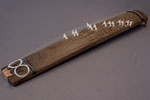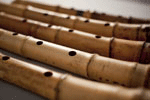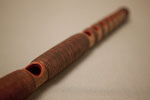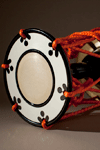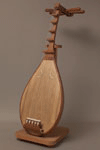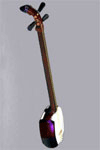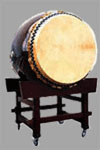
TSUDUMI
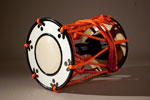
Tsuzumi are struck percussion instruments used in noh and kabuki music and broadly categorised into kotsuzumi and ōtsuzumi.
In kabuki music kotsuzumi is simply referred to as tsuzumi and ōtsuzumi is called ōkawa. Both consist of a wooden body tucked between two skins stretched over iron rings, held together by a cord, shirabe, that is attached to each ring. Kotsuzumi are held in the left hand by the shirabe and rested on the right shoulder. By altering the grip on the shirabe while striking the front skin with the right hand, a variety of tones can be produced. Ōtsuzumi on the other hand have skins that are dried out before being tightly tied together and also are held on the players left side and struck with the right hand. While only producing one kind of high pitched sound, the key can be varied through altering the volume and timbre. In noh (Japanese plays) music, kotsuzumi and ōtsuzumi, along with taiko drums and fue, transverse flutes, make up the standard four piece ensemble. By adding an utai, or noh singer, it becomes a five person hayashi instrumental ensemble made well known through hina dolls. Often in kabuki, Japanese theatre, the larger numbers of kotsuzumi players are lined up along tiers on the stage. Another feature is the intricate rhythm called chirikara-byōshi synched with the rhythm of shamisen music typified in nagauta.
Music Library
- Nami-Gashira
- Composer UNK*
- Year UNK*
- play
- under construction
- Shidai
- Composer UNK*
- Year UNK*
- play
- under construction
- Ichiyōraifuku
- Composer UNK*
- 2007
- play
- under construction
*Composer UNK:Name of composer unknown. Year UNK:Year of composition unknown.
Performance by Hiromitsu Nishikawa
In each episode, when staff notation is applicable, it is standardized by absolute pitch notation.
























